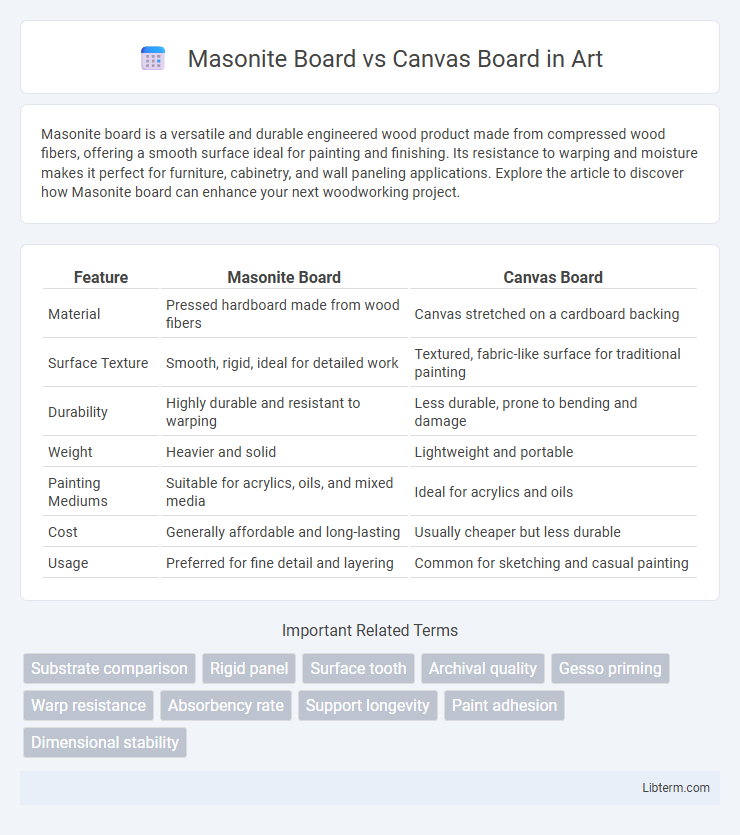Masonite board is a versatile and durable engineered wood product made from compressed wood fibers, offering a smooth surface ideal for painting and finishing. Its resistance to warping and moisture makes it perfect for furniture, cabinetry, and wall paneling applications. Explore the article to discover how Masonite board can enhance your next woodworking project.
Table of Comparison
| Feature | Masonite Board | Canvas Board |
|---|---|---|
| Material | Pressed hardboard made from wood fibers | Canvas stretched on a cardboard backing |
| Surface Texture | Smooth, rigid, ideal for detailed work | Textured, fabric-like surface for traditional painting |
| Durability | Highly durable and resistant to warping | Less durable, prone to bending and damage |
| Weight | Heavier and solid | Lightweight and portable |
| Painting Mediums | Suitable for acrylics, oils, and mixed media | Ideal for acrylics and oils |
| Cost | Generally affordable and long-lasting | Usually cheaper but less durable |
| Usage | Preferred for fine detail and layering | Common for sketching and casual painting |
Introduction to Masonite and Canvas Boards
Masonite board is a durable, smooth, and rigid surface made from compressed wood fibers, frequently used as a painting support in both acrylic and oil mediums due to its resistance to warping and ease of priming. Canvas board features a canvas fabric adhered to a rigid backing, offering a lightweight, portable option ideal for beginners and quick studies, often chosen for its textured surface that enhances paint adhesion and brushstroke detail. Both materials serve as popular painting surfaces but vary significantly in texture, durability, and handling characteristics, influencing artists' choice based on project requirements.
Material Composition: Masonite vs Canvas Board
Masonite board is made from hardboard, a dense engineered wood product derived from wood fibers compressed under high heat and pressure, providing a smooth, hard surface ideal for detailed painting techniques. Canvas board consists of a canvas fabric, typically cotton or linen, mounted and glued onto a sturdy cardboard backing, offering a textured surface that mimics traditional stretched canvas but with increased portability. The rigidity and smoothness of Masonite contrast with the flexible, textured composition of canvas board, influencing the choice based on artistic technique and desired finish.
Surface Texture and Preparation
Masonite boards feature a smooth, hard surface ideal for acrylic and oil painting, requiring minimal preparation but sometimes benefiting from a primer to enhance paint adhesion. Canvas boards offer a textured, fabric surface that mimics traditional canvas, often pre-primed to provide a suitable base for various paint mediums. The choice between smooth Masonite and textured canvas boards depends on the desired finish and paint application technique.
Durability and Longevity Comparison
Masonite board offers superior durability compared to canvas board due to its hard, smooth surface that resists warping, moisture, and physical damage over time. Canvas board, while lightweight and flexible, is prone to sagging, tearing, and degradation when exposed to humidity or frequent handling. For artists seeking long-lasting support that withstands environmental challenges, Masonite board provides a more stable and enduring painting surface.
Weight and Portability Differences
Masonite board is heavier and denser than canvas board, making it less portable but highly durable for detailed painting work. Canvas boards are lightweight and easy to carry, ideal for artists who travel or paint outdoors. The significant weight difference impacts convenience, with canvas boards favored for portability and Masonite for stability.
Ease of Framing and Mounting
Masonite board offers a smooth, rigid surface that is highly durable and easy to frame due to its uniform thickness and resistance to warping, making it ideal for long-term mounting. Canvas board, while lightweight and more flexible, typically requires additional stretching or reinforcing before framing, which can complicate the mounting process. For artists or decorators seeking straightforward framing with minimal preparation, Masonite board provides a more stable and hassle-free option compared to canvas board.
Suitability for Various Painting Mediums
Masonite board offers a rigid and durable surface ideal for acrylics, oils, and mixed media, providing excellent support and preventing warping. Canvas board, made from canvas stretched over a cardboard backing, suits watercolors, acrylics, and oils but may not withstand heavy varnishing or excessive layering as well as Masonite. Artists working with heavy-bodied paints or requiring a stable, long-lasting surface often prefer Masonite board for its strength and resilience.
Cost Comparison: Masonite Board vs Canvas Board
Masonite boards typically cost more upfront than canvas boards, with prices ranging from $10 to $30 depending on size and thickness, while canvas boards usually range from $5 to $15. Despite the higher initial cost, Masonite offers greater durability and longevity, potentially providing better value for long-term projects or artworks meant for preservation. Canvas boards, being lighter and more affordable, are often preferred for practice or short-term pieces where budget constraints are a priority.
Professional Artist Preferences
Professional artists often prefer Masonite board for its smooth, rigid surface that supports detailed brushwork and durability, making it ideal for acrylic and oil paintings. Canvas board is favored for its lightweight, portable nature and textured surface, which mimics stretched canvas but may warp over time. The choice between Masonite and canvas boards depends on an artist's need for stability, texture, and medium compatibility in their professional work.
Choosing the Right Board for Your Art Project
Masonite board offers a durable, smooth surface ideal for detailed painting and mixed media projects, providing excellent support and resistance to warping. Canvas board, made from canvas stretched over a stiff backing, mimics the texture of traditional canvas at a lower cost and is lightweight, making it suitable for quick studies and portable works. Selecting the right board depends on the desired texture, durability, and the specific medium you plan to use, with Masonite favoring longevity and polished finishes, while canvas boards prioritize affordability and ease of transport.
Masonite Board Infographic

 libterm.com
libterm.com